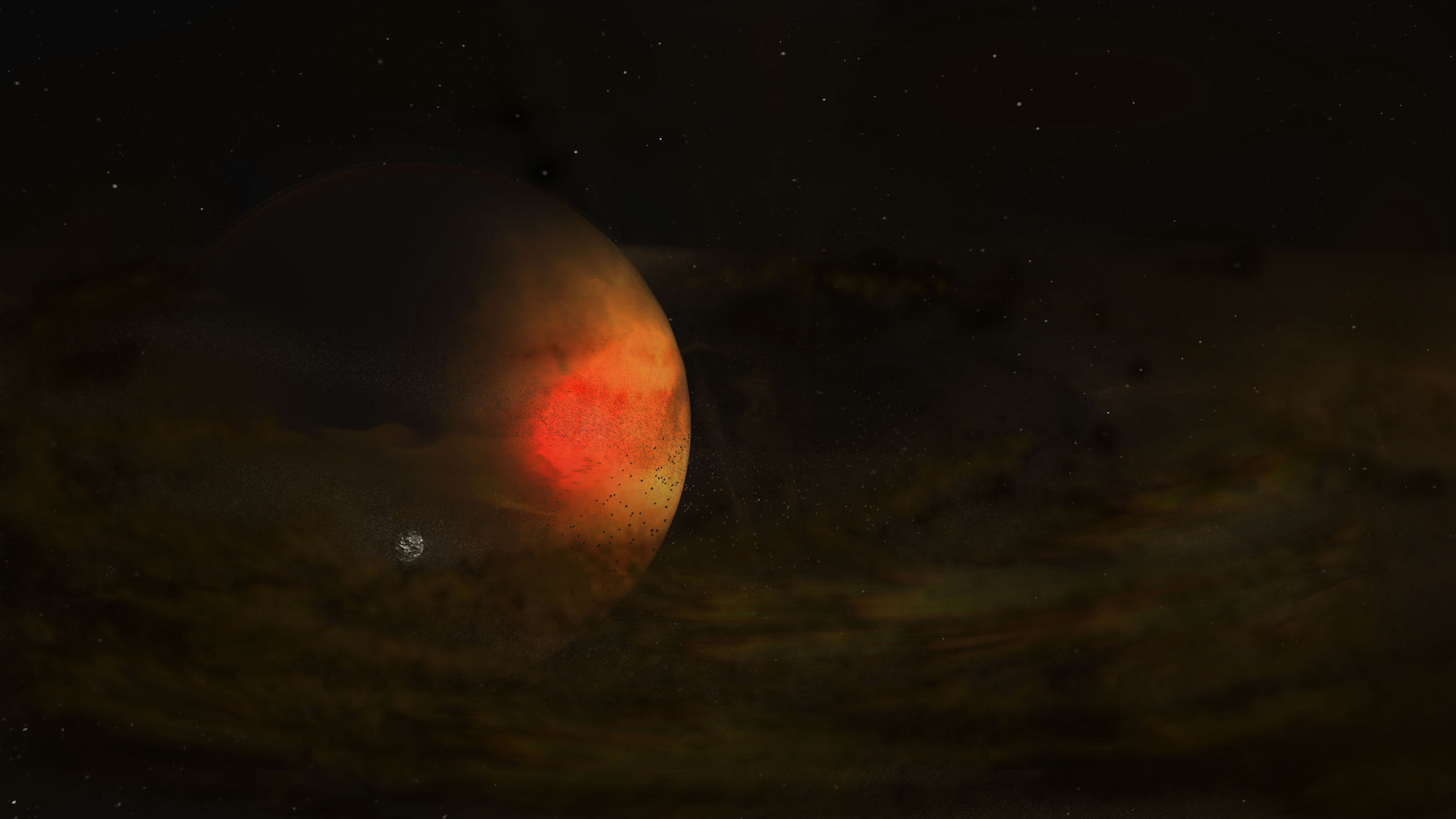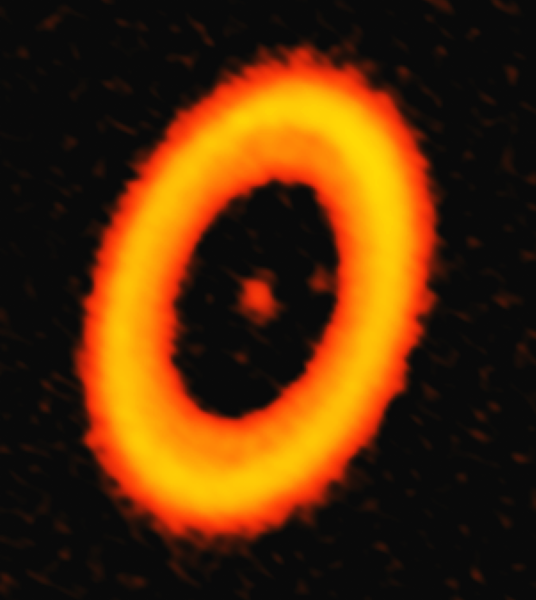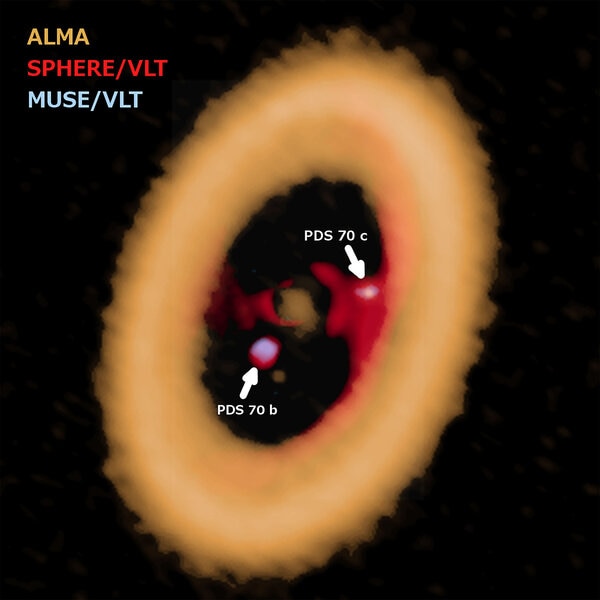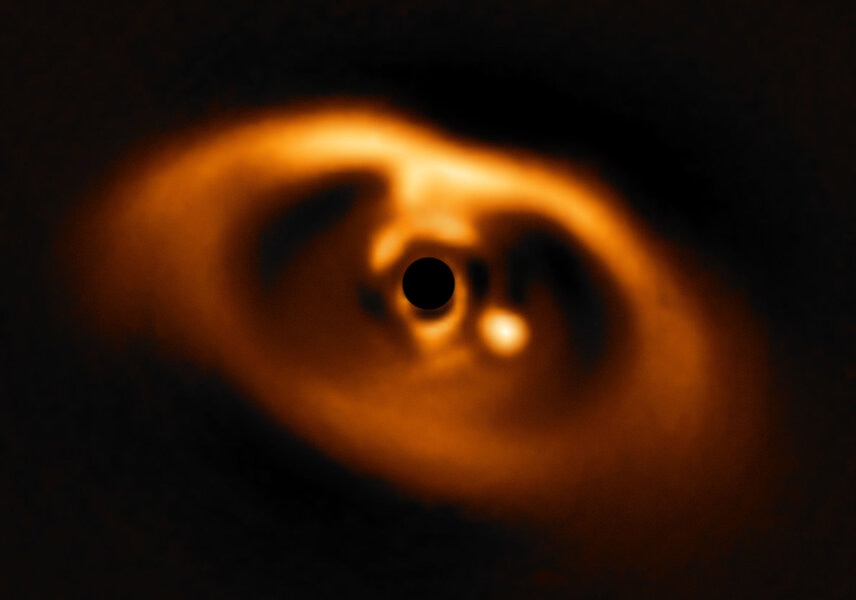Create a free profile to get unlimited access to exclusive videos, sweepstakes, and more!
ALMA reveals a dusty ring around a young exoplanet that may be forming moons

Moons abound in our solar system; nearly every planet has at least one. There are many ways moons can form, but one way is that they are born along with the planet (hang on a sec and I’ll get to that below). Given how many moons we have locally, we figure that they abound in other solar systems, too.
We haven’t seen any exomoons yet. They’re ridiculously hard to detect. But new observations indicate that at least one newborn planet circling a nearby star is still surrounded by a disk of dust, exactly the sort of thing we think moons form out of. In other words, we may be seeing the birthplace of an exomoon or exomoons.
Holy wow.
To be clear, we don’t know if moons actually are or have formed from this material. But it’s the first time a disk around a planet has ever been detected with confidence, so it seems like a fair bet.
The observations were made using the Atacama Large Millimeter/submillimeter Array (ALMA), a collection of dishes in the high desert plains of Chile. ALMA looks at light far outside what our eyes can see, with wavelengths around a millimeter or smaller. That’s out past the infrared and microwave part of the electromagnetic spectrum, but not quite as long a wavelength as radio waves.
This is the perfect wavelength to look for the dusty environments around young exoplanets. Stars don’t put out much light in the millimeter range, but the dust surrounding them after they’re born glows brightly there. This is the same dust planets form from.
In a nutshell, clouds of gas and dust can collapse (maybe they get hit by the wind from a powerful nearby star, or a supernova, or two clouds collide). When they do, the material flattens into a giant rotating disk, usually tens or hundreds of billions of kilometers across. The star forms in the center. Farther out in the disk, clumps of stuff start to form, aggregating together over some millions of years to form planets. If a planet is massive enough (roughly ten times Earth’s mass) then it can crave a gap in the dust ring, collecting material from it gravitationally.
This material forms a disk around the planet, called a circumplanetary disk (or CPD). A lot of the material from this disk eventually falls onto the planet, but some can also clump together as it orbits, forming moons.
Several young exoplanets observed have been thought to have CPDs, but the observations weren’t quite certain enough to make the claim… until now.
PDS 70 is a very young star, probably about 5 million years old, located about 370 light years away. A disk of material around the star was first seen in 2002. The disk is actually two rings of dust and gas, one close in to the star and a larger one much farther out, with a big gap between them. In 2018 an actively forming planet was seen in that gap, about 3.5 billion kilometers from the star (a little farther out than Uranus is from the Sun), directly detectable in infrared images taken using the Very Large Telescope. Called PDS 70b, it was found to be growing pretty rapidly, indicating it really is very young.
Then, in 2019, a second planet was found orbiting the star as well. Called PDS 70c, it’s farther out than PDS 70b, orbiting the star just inside the inner edge of the outer ring, about 5.3 billion km from the star (a bit farther than Neptune is from the Sun).
The new ALMA images go farther than that. They detect the outer ring, and both planets. But there’s a twist. At these wavelengths, the planet is predicted to be relatively faint. However, PDS 70c is much brighter than expected. The simplest explanation is that it’s surrounded by its own disk of material, its own CPD. This disk is far too small to be resolved by ALMA, but the observations fit with it being a disk made of warm dust. This is the first time such a disk has been detected with confidence.
The amount of material in the disk is low, indicating the planet may be in the late stages of formation, and has already siphoned out most of the material from the CPD it can. But this disk, besides feeding the planet, is where astronomers think moons form, too.
So again, we can’t say for sure there are moons there, but I’d venture to say it’s the way to bet. The disk around PDS 70c probably has a mass of a tenth or so of the Earth in total (dust plus gas); for comparison the Moon has a mass of 1/80th the Earth. So there’s plenty of moon-making material there (though, to be fair, it’s the dust that makes up the bulk of the moon, and there’s much less dust than gas; still, enough to form moons).
Weirdly, no such disk was seen around PDS 70b. But even weirder is that ALMA saw a bright patch of what may be dust close to but apparently not in the same spot as the planet. It’s possible, barely, that it is coincident with the planet (the exact location is difficult to ascertain in the data) but it’s more likely displaced from it. What could that be? The astronomers aren’t sure, though they speculate it could be material lagging behind the planet as it orbits the Sun, trapped in a special gravitational region called a Lagrange point (specifically L5), where the gravity and centrifugal forces balance, allowing particles to accumulate there. But that’s not at all clear.
So, wow. A lot going on in this system, made even more amazing in that we’ve only known about 70b for a year and 70c for less than that! As I wrote yesterday, we’ve only just barely started finding exoplanets in bulk, with 4,000+ now known. We’re getting so good at observing them, at creating telescopes and detectors and software to observe and analyze them, that the discoveries are now pouring in.
I imagine we’ll be seeing even more disks around planets soon, with more than enough mass to create a system of moons. And we’re on the bleeding edge of finding already-formed moons in observations as well.
We think planets outnumber stars in the sky. Moons will certainly outnumber planets. And we’ve found that a dozen or so moons in our own solar system have oceans of liquid water under their frozen surfaces. When I think about the implications of this on finding life in the Universe, my heart soars.
That may be a long time yet from now, but I really do think that time is coming. And what a time that will be.






























